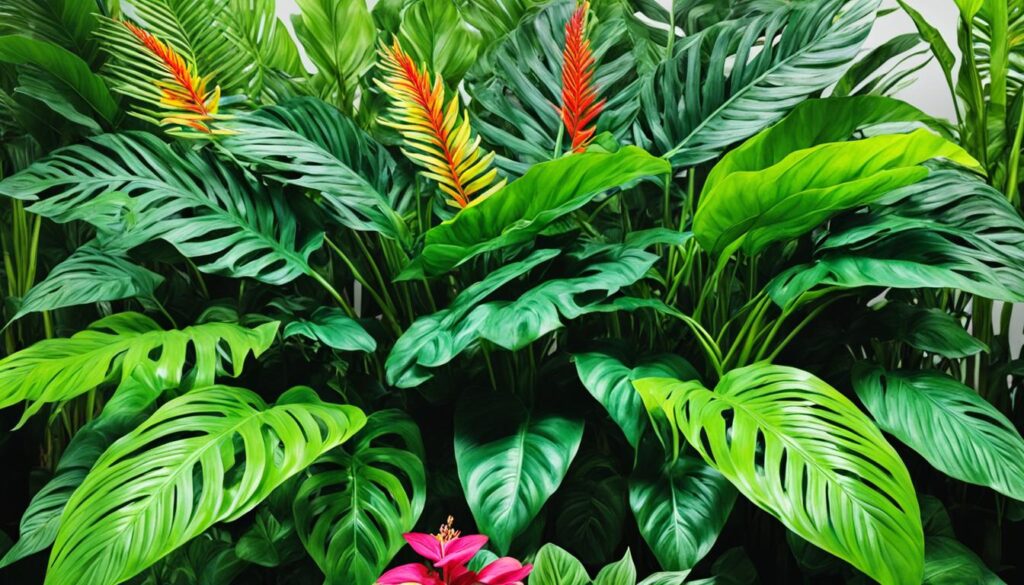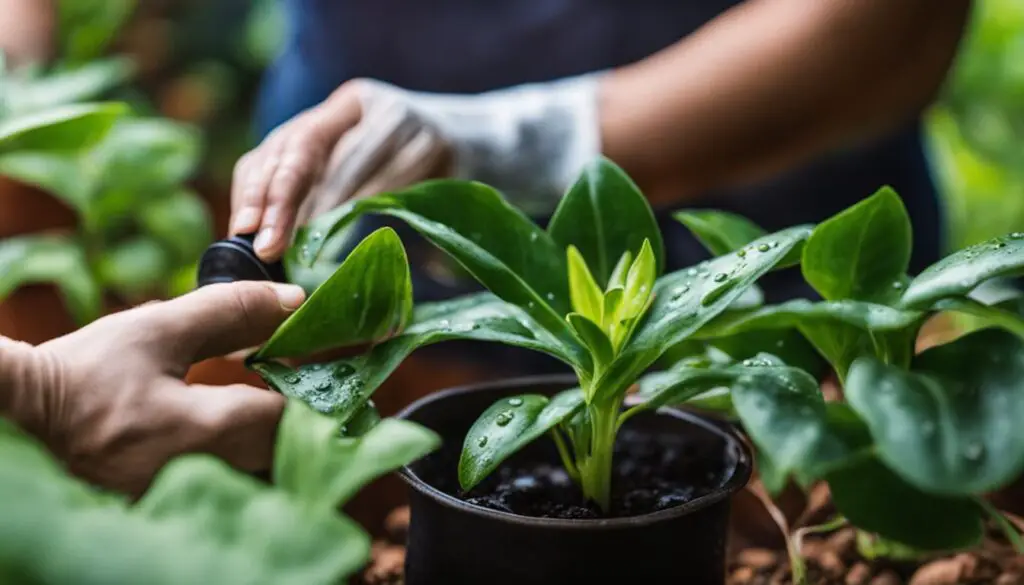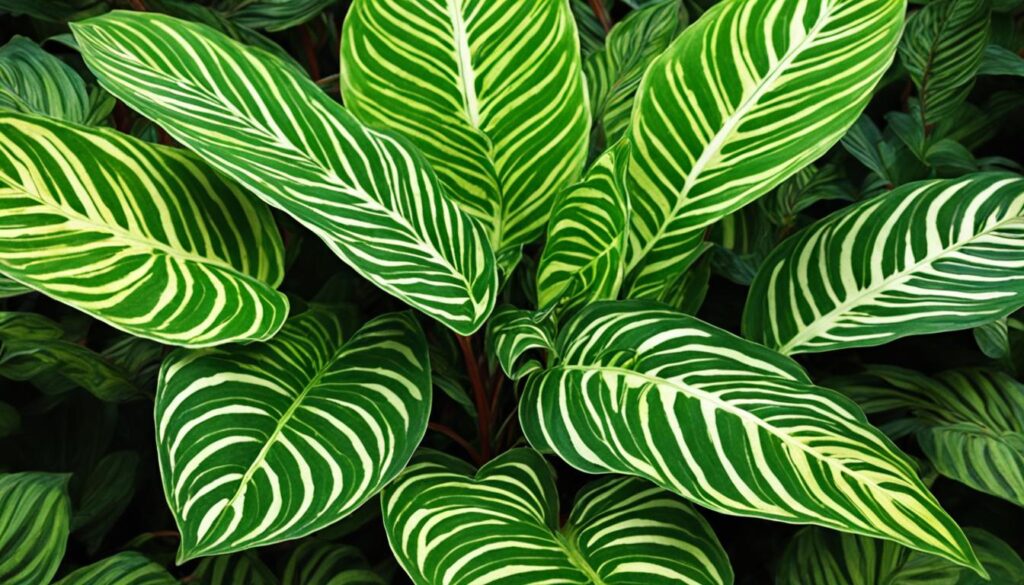Discover the fascinating history and cultural significance of prayer plants as we take a journey through time. From their ancient origins to their evolution and cultivation over the ages, the prayer plant holds a treasured place in the hearts of plant enthusiasts around the world.
Key Takeaways:
- Prayer plants have a rich historical background, with origins in Central and South America.
- They were named for their use in prayer books by practitioners, symbolizing devotion.
- Prayer plants are known for their vibrant foliage and unique leaf movement.
- They possess spiritual qualities and have been associated with healing properties.
- Throughout history, prayer plants have been used for various purposes, including food and medicine.
The Spiritual Qualities of Prayer Plants
Prayer plants possess unique spiritual qualities and symbolism that resonate with many cultures. These plants are believed to emit a religious aura, promoting positive energy, blessings, and spiritual cleansing. People cultivate prayer plants as a means to connect with the divine and seek resolution to conflicts within their spiritual journey.
The most remarkable characteristic of prayer plants is their leaf movement, which adds to their spiritual aura. The leaves of prayer plants unfold during the day, revealing intricate patterns that resemble hands folded in prayer. This natural movement symbolizes devotion and serves as a visual representation of spiritual reflection.
“The spiritual qualities of prayer plants go beyond their physical beauty. They invite us to embrace mindfulness and find solace in the act of prayer itself.”
While there is no concrete evidence to support the magical properties attributed to prayer plants, their spiritual significance has been recognized for centuries. These plants hold a symbolic connection to the sacred and are regarded as a tool for spiritual growth and enlightenment.
Plant symbolism is deeply ingrained in human culture, and prayer plants contribute to this rich tapestry. For many, the presence of these plants in their homes or sacred spaces serves as a reminder of their relationship with the divine and the importance of spiritual nourishment.
- Emits a religious aura
- Symbolizes positive energy, blessings, and spiritual cleansing
- Facilitates a connection with the divine
- Reflects devotion and symbolism through leaf movement
- Recognized for their spiritual significance for centuries
- Contributes to plant symbolism and spiritual nourishment
While the spiritual qualities of prayer plants may be subjective, their presence in our lives can serve as a gentle reminder to prioritize our spiritual well-being, find solace in prayer, and embrace the symbolism they offer.
| Spiritual Qualities of Prayer Plants | Description |
|---|---|
| Religious Aura | Prayer plants emit a unique energy that resonates with the sacred. |
| Spiritual Cleansing | They are believed to possess the power to purify and uplift spiritual energies. |
| Connection with the Divine | Prayer plants serve as a conduit to establish a deeper connection with the divine. |
| Symbolism | The leaf movement of prayer plants symbolizes hands folded in prayer, reflecting devotion and spiritual reflection. |

Botanical Origins of Prayer Plants
Prayer plants, scientifically known as Maranta leuconeura, trace their roots back to the tropical regions of Central and South America. These captivating plants belong to the Marantaceae family, renowned for their vibrant foliage and intricate patterns. However, what truly sets prayer plants apart is their exceptional leaf movement, which unfolds during the day, revealing mesmerizing patterns, and then folds upward as if in prayer during the evening.
This distinctive characteristic has fascinated individuals for centuries, adding to the allure and mystique of prayer plants. Native to their tropical origins, these plants thrive in warm, humid environments, replicating their natural habitat and showcasing their remarkable leaf movements.

The Marantaceae Family
As members of the Marantaceae family, prayer plants share a botanical lineage with other remarkable plants known for their beautiful foliage. This plant family comprises numerous species with intricate leaf patterns and vibrant colors, making them highly sought-after by enthusiasts and collectors.
Prayer plants, in particular, showcase an array of captivating leaf patterns that add visual interest to any environment. From delicate veins resembling lacework to striking contrasts of color, the Marantaceae family excels in delivering stunning and visually engaging foliage.
The Unique Leaf Movement
While the Marantaceae family boasts a variety of captivating traits, the defining characteristic that sets prayer plants apart is their unique leaf movement. As the day progresses, the leaves slowly unfurl, revealing vivid patterns and hues. This dynamic display is reminiscent of the radiance found in the tropical regions of Central and South America.
“The intricate leaf movement of prayer plants is like a choreographed dance, captivating all who witness its beauty.”
When evening arrives, the leaves of prayer plants gracefully fold upward, mimicking hands clasped in prayer. This natural phenomenon not only adds to the plant’s visual appeal but also contributes to its symbolic representation as a plant of devotion and spirituality.
| Botanical Origins | Key Features |
|---|---|
| Tropical regions of Central and South America | – Warm and humid climate – Lush, vibrant foliage – Intricate leaf patterns – Unique leaf movement |
With their tropical origins, membership in the Marantaceae family, and distinctive leaf movement, prayer plants continue to captivate the hearts and minds of plant enthusiasts around the world.
Folklore Surrounding Prayer Plants
Prayer plants have a rich folklore surrounding them. Throughout history, these plants have been associated with various beliefs and magical properties. While some claims lack concrete evidence, they contribute to the captivating mystique and cultural significance of prayer plants.
Healing Properties and Good Luck Charms
According to prayer plant folklore, these plants are believed to possess healing properties. It is said that their presence can promote physical and emotional well-being. Additionally, prayer plants are often considered symbols of good luck. Placing them in homes or workplaces is believed to attract positive energy and bring blessings to those who possess them.
Warding Off Evil and Granting Wishes
Another intriguing aspect of prayer plant folklore is their supposed ability to ward off evil spirits. In some cultures, it is believed that having a prayer plant in your home can create a protective barrier against negative energies or malevolent influences. Prayer plants are also associated with granting wishes. It is said that if you make a wish while tending to your prayer plant, it will help manifest your desires.
“Prayer plants are not only beautiful houseplants; they are also seen as vessels of positive energy and spiritual power.” – Plant Enthusiast Magazine
While these beliefs may vary across different cultures and regions, the folklore surrounding prayer plants adds an element of magic and wonder to their already beautiful and captivating nature.

Discover the enchanting prayer plant folklore and explore the world of spiritual symbolism and mystical properties associated with these fascinating plants.
Care Tips for Prayer Plants
Proper care is essential for maintaining the health and beauty of your prayer plants. By following these care tips, you can ensure that your prayer plants thrive and continue to bring vibrancy to your space.
1. High Humidity
Prayer plants thrive in high humidity environments, replicating their natural tropical habitat. To provide adequate humidity, consider placing your prayer plant in a bathroom or near a humidifier. Mist the leaves regularly to further increase humidity levels.
2. Bright Light
Although prayer plants do not thrive in direct sunlight, they require bright, indirect light. Place your prayer plant near a window that receives filtered sunlight throughout the day. Avoid exposing them to intense midday sun, as it can scorch the leaves.
3. Moist Soil
Prayer plants prefer consistently moist soil. Ensure that the soil is well-draining to prevent overwatering, which can lead to root rot. Water the plant when the top inch of soil feels dry. Make sure to use room-temperature water to avoid shocking the roots.
4. Liquid Fertilizer
To promote healthy growth and vibrant foliage, fertilize your prayer plant with a balanced liquid fertilizer once a month during the growing season. Follow the instructions on the fertilizer packaging for proper application to avoid over-fertilization.
5. Winter Care
During the winter months, prayer plants enter a period of dormancy. Reduce watering frequency and move the plant to a slightly darker location with less direct light. Be cautious not to let the soil completely dry out during this time, as it can cause stress to the plant.

By providing your prayer plants with the care they need, you can enjoy their striking leaf patterns and bask in their natural beauty. Remember to maintain high humidity, provide bright indirect light, keep the soil moist, fertilize regularly, and adjust care during the winter months.
| Care Tips for Prayer Plants |
|---|
| High Humidity |
| Bright Light |
| Moist Soil |
| Liquid Fertilizer |
| Winter Care |
Uses of Prayer Plants
Throughout history, prayer plants have been cherished for their versatile uses, ranging from culinary to medicinal. The various parts of the plant offer a wide range of benefits and have been utilized by different cultures around the world.
Edible Roots, Leaves, and Flowers
Prayer plants offer edible roots, leaves, and flowers, providing a unique culinary experience. The roots have a slightly sweet taste and can be consumed raw or cooked, making them a delightful addition to salads or stir-fries. Although the leaves and flowers have a bitter flavor, they are also edible and can be incorporated into dishes for added nutrition and visual appeal.
Nutritional Benefits
Prayer plants are not only delicious but also packed with nutritional goodness. They are known for their high protein content, making them an excellent choice for individuals looking to increase their protein intake. Additionally, prayer plants are rich sources of vitamins A and C, which are essential for maintaining a healthy immune system and promoting overall well-being.
| Nutrient | Value per 100g |
|---|---|
| Protein | 7g |
| Vitamin A | 1500 IU |
| Vitamin C | 30mg |
Medicinal Uses
Prayer plants have a long history of medicinal uses, particularly in traditional Native American medicine. The plant has been used to treat respiratory problems, such as coughs and congestion, as well as fevers and other illnesses. The healing properties of prayer plants make them a valuable natural remedy to alleviate various ailments.
Prayer plants have been prized for their culinary and medicinal uses throughout history. From their edible roots, leaves, and flowers to their high protein content and vitamins A and C, these plants offer both nourishment and healing potential.
As we delve into the world of prayer plants, it becomes evident that their significance extends beyond their spiritual symbolism and captivating leaf movement. Their rich history of food and medicinal uses adds another layer of appreciation for these remarkable plants.
The Origins of the Name “Prayer Plant”
The name “prayer plant” arises from the unique leaf movement of the plant, which bears a resemblance to hands folded in prayer. This distinctive characteristic has bestowed upon it a cultural significance, associating it with devotion and symbolism in religious practices. The folding motion of the leaves reflects the act of spiritual reflection and prayer itself, making the prayer plant a compelling symbol of faith. Many believe that having a prayer plant at home can bring blessings and protection, making it a meaningful addition to any space.

Other Names for Prayer Plants
Prayer plants are also known by other names, such as the Maranta plant. Different varieties of prayer plants include the red prayer plant and the herringbone plant.
- The red prayer plant, scientifically known as Maranta leuconeura, features striking red veins on its green leaves. This vibrant combination adds a dramatic touch to any indoor space.
- The herringbone plant, scientifically known as Maranta bicolor, gets its name from the intricate patterns on its leaves that resemble fishbones. The delicate crisscrossing lines create a visually captivating display.
These alternative names reflect the diverse leaf patterns seen in different prayer plant varieties. Whether it’s the bold red veins of the red prayer plant or the intricate fishbone patterns of the herringbone plant, prayer plants offer a range of visually stunning options for plant enthusiasts.
Troubleshooting Common Issues with Prayer Plants
If your prayer plant is not displaying its characteristic leaf movement, there may be several reasons to consider. Insufficient light, inconsistent temperature levels, underwatering, or overwatering can all impact the plant’s ability to fold its leaves properly.
To ensure your prayer plant thrives, keep in mind the following care tips:
- Insufficient Light: Prayer plants require bright, indirect light to maintain their leaf movement. If your plant is kept in a dimly lit area, consider moving it to a spot where it can receive more light.
- Inconsistent Temperature Levels: Prayer plants prefer consistent temperatures between 65-75°F (18-24°C). Avoid exposing them to extreme temperature fluctuations, such as drafts from open windows or heating vents.
- Underwatering: Make sure to water your prayer plant thoroughly when the top inch of soil feels dry. Underwatering can cause the leaves to droop and affect their ability to fold properly.
- Overwatering: Overwatering can lead to root rot and hinder the plant’s overall health. Allow the soil to dry out slightly between watering sessions, ensuring adequate drainage.
- Pests: Common pests, such as spider mites or mealybugs, can infest prayer plants and affect their leaf movement. Regularly check your plant for any signs of pest activity and take appropriate measures to eliminate them.
By providing your prayer plant with the right conditions, including proper lighting, consistent temperature levels, and appropriate watering, you can help ensure its leaves display the beautiful folding movement for which it is known.
Placement and Propagation of Prayer Plants
Proper placement and propagation are vital for the optimal growth and vitality of prayer plants. By providing the right conditions and using suitable propagation methods, you can ensure the success of these beautiful plants in your home.
Optimal Placement
To thrive, prayer plants require bright, indirect light. Find a spot in your home where they can receive a good amount of bright but filtered light. Avoid placing them in direct sunlight, as it can lead to leaf burn. An ideal location could be a room with a window that provides bright, indirect light throughout the day.
Temperature levels also play a crucial role in the growth of prayer plants. They prefer temperatures between 65-75°F (18-24°C). Avoid placing them in areas with extreme temperature fluctuations or drafts, as it can cause stress to the plants. Consistent temperature levels will help maintain their health and encourage vigorous growth.
In addition to light and temperature, prayer plants thrive in well-draining soil. Ensure the soil is loose and has good drainage to prevent waterlogging. Well-draining soil helps prevent root rot and other issues that can arise from overwatering.
Propagation Methods
There are two common methods for propagating prayer plants: division and stem cuttings.
Division: To propagate through division, carefully remove the prayer plant from its pot and separate the root system into smaller sections. Each section should have stems and roots attached. Plant the divided sections in individual pots with fresh well-draining soil. Water thoroughly and place them in a location with bright, indirect light. With time, each division will develop into a new plant.
Stem Cuttings: Another propagation method is through stem cuttings. Select a healthy stem with at least two or three leaves, and make a clean cut just below a leaf node. Place the cutting in a container with water, ensuring the node is submerged, and keep it in a location with bright, indirect light. After a few weeks, roots will begin to develop. Once the roots are well-established, transfer the cutting into a pot with well-draining soil and continue caring for it as you would for a mature prayer plant.
By placing prayer plants in optimal conditions and using appropriate propagation methods, you can enjoy a flourishing collection of these stunning plants.
The Unveiling Ceremony and Prayers
The unveiling of a prayer plant headstone is a private ceremony that holds deep significance for family and close friends. This solemn event allows loved ones to gather and pay their respects, honoring the memory of the departed. The unveiling service typically includes heartfelt prayers, an abbreviated eulogy, and the recitation of the Kaddish, a Jewish prayer for the deceased. Led by a rabbi or cantor, the ceremony provides solace and a sense of closure in times of grief.
By coming together in this private ceremony, family members can find comfort and support in their shared mourning. The unveiling ritual not only aids in the healing process but also adds to the collective memory of the Jewish community. It is a time to reflect on the impact and legacy of the departed and to seek solace in the presence of loved ones.
Private Ceremony and Graveside Rituals
The private nature of the unveiling ceremony allows for intimate and personal remembrance. It offers an opportunity for family and close friends to express their ongoing grief and share stories and anecdotes about the departed. This heartfelt gathering serves as a reminder of the significance of life and the enduring bonds of love.
Graveside rituals are an integral part of the unveiling service. Placing flowers or small stones on the headstone is a way to show respect and honor the memory of the deceased. These symbolic gestures carry deep meaning and provide a sense of connection between the living and the departed.
“Through prayers and shared memories, the unveiling ceremony becomes a powerful moment of reflection, healing, and remembrance for those left behind.”
| Unveiling Ceremony Components | Description |
|---|---|
| Prayers | Heartfelt prayers are recited to honor the departed’s memory and seek solace in times of grief. |
| Eulogy | An abbreviated eulogy is often delivered, highlighting the life, accomplishments, and legacy of the departed. |
| Kaddish | The Kaddish, a traditional Jewish prayer for the deceased, is recited to offer comfort and sanctity. |
| Private Ceremony | The unveiling service is a private gathering attended by close family and friends. |
| Graveside Rituals | Symbolic gestures such as placing flowers or stones on the headstone are performed to pay respects and honor the memory of the departed. |
Conclusion
The prayer plant holds immense significance in both history and culture, tracing its origins back to Central and South America. Throughout the ages, it has been revered for its spiritual symbolism, healing properties, and cultural heritage. The plant’s unique leaf movement and vibrant foliage continue to captivate people around the world.
Prayer plants have been used for spiritual purposes, symbolizing devotion and providing a sense of connection with the divine. In different cultures, they have often been associated with blessings, positive energy, and spiritual cleansing. While its magical properties may not be scientifically proven, the plant’s spiritual significance has stood the test of time.
Furthermore, the prayer plant’s cultural heritage adds to its allure. It has been used by prayer practitioners throughout history, with its leaves adorning prayer books. In addition, the plant has been utilized for its healing properties, with Native Americans traditionally using it to treat various ailments.
Whether grown for its visual beauty, its spiritual symbolism, or its culinary uses, the prayer plant remains a captivating and cherished plant that holds a special place in the hearts of many.
FAQ
What is the history of prayer plants?
The prayer plant has a rich history and cultural significance, with origins in Central and South America. It has been used for spiritual purposes, as a symbol of devotion, and for its healing properties.
Why are prayer plants associated with spirituality?
Prayer plants are believed to possess spiritual qualities and symbolism. Some cultures associate the plant with positive energy, blessings, and spiritual cleansing. People use it to connect with the divine and resolve conflicts.
Where do prayer plants originate from?
Prayer plants have their roots in the tropical regions of Central and South America. They belong to the Marantaceae family, known for their vibrant foliage and intricate patterns.
What is the folklore surrounding prayer plants?
Prayer plants have been associated with healing properties, good luck, and the ability to ward off evil. Some believe that they possess magical properties and can even grant wishes.
How should I care for prayer plants?
Prayer plants prefer high humidity and thrive in bright, indirect light. They grow best in moist soil and should be watered regularly. They also appreciate being placed in a humid environment, such as a bathroom or near a humidifier.
What are the uses of prayer plants?
Throughout history, prayer plants have been used as food and medicine. The roots, leaves, and flowers are edible and high in protein and vitamins. Native Americans have traditionally used them to treat respiratory problems and fevers.
How did prayer plants get their name?
The prayer plant is named for its unique leaf movement, which resembles hands folded in prayer. This characteristic led to its association with devotion and symbolism in religious practices.
What are some alternative names for prayer plants?
Prayer plants are also known as Maranta plants. Different varieties include the red prayer plant, which has striking red veins on its leaves, and the herringbone plant, which features intricate patterns resembling fishbones.
What should I do if my prayer plant doesn’t fold its leaves properly?
Insufficient light, inconsistent temperature levels, underwatering, or overwatering can affect the leaf movement of prayer plants. They require bright, indirect light, consistent temperatures, and well-draining soil.
How should I place and propagate prayer plants?
Prayer plants thrive in bright, indirect light and consistent temperature levels. They can be propagated through division or stem cuttings, both of which require well-draining soil.
What happens during an unveiling ceremony for prayer plants?
The unveiling ceremony is a private event attended by family and close friends. It includes prayers, an abbreviated eulogy, and the recitation of the Kaddish. It allows family members to honor the memory of the departed and aids in the healing process.
What is the significance of prayer plants?
Prayer plants hold a significant place in history and culture, with their origins in Central and South America. They have been used for spiritual purposes, as symbols of devotion, and for their healing properties.









